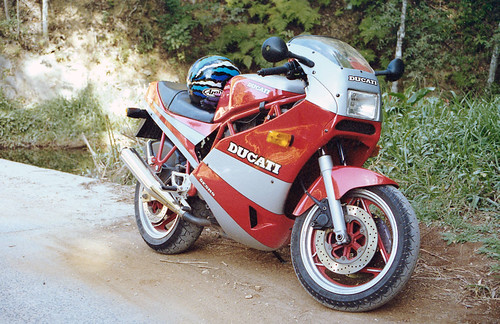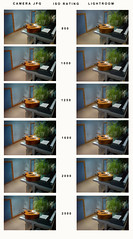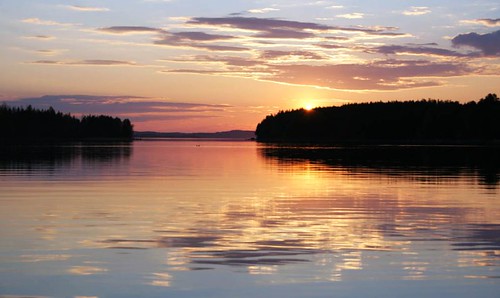While this blog post is ostensibly about images, its also about how producers spend their R&D budget for products and what goes into production.
 Let me start with an analogy.
Let me start with an analogy.This is my Ducati, its a 1989 750 Sport and was made by Ducati before the modern SS series really took hold of the market.
It was made at a time when their budget was small and they were owned by Cagiva. The company was trying hard to catch up with the Japanese bikes which had long since stopped being the wobbly things which took a genius gifted rider like Mike Hailwood to tame and bring to fame.
Based on the frames used in the race proven 750 F1 bikes, the 750 Sport had a real packet of problems to present for the owner. It was in many ways as frustrating to own as it was fantastic to own.
After decades of ownership of Hondas and Yamaha motorcycles owning the 750 Sport was an elegant exercise in understanding what it was the separated the two philosophies and the budgets. Yamaha no doubt had a small group of people dedicated to solving specific issues such as where to put the battery. Ducati on the other hand had clearly just a couple of hours to sort out where to put a battery in the frame (and undoubtedly the race bikes did not have them) and chose perhaps the worst possible location imaginable.
Check out how many 750 Sport owners have the knee of their jeans speckled with holes from battery acid spitting out ...
Just like motorcycles, camera makers have similar production and design issues and looking at an image from my friend over at Soundimageplus, I think I am seeing one. He posted this image recently on his blog, to examine what he finds on his Leica M9 (the lucky lucky bastard)
 Looking at a strip he has placed on Flickr, he's photographed a scene at a variety of ISO's and then compared camera JPG to what he can get with LR and no particular massive amount of work.
Looking at a strip he has placed on Flickr, he's photographed a scene at a variety of ISO's and then compared camera JPG to what he can get with LR and no particular massive amount of work.Its interesting to see just how much better the LR images are compared to the in-camera JPG images.
Now, looking at this thumbnail set to the left here they all show really similar colour rendition, and that's a good thing. The JPG thumbnails also seem to be punchier. But its when you look at the image carefully you start to see that the JPG engine employed by Leica is really not anywhere near as good as those of companies like Canon (who are finally starting to get theirs in good order) Nikon or Panasonic (whom I'm getting more and more respect for with every RAW file I process).
Lets look first at a moderate sample, not this is not incredibly zoomed in or pixel peeped in any way.
First, this is an overview (yes, just an overview) of the red channel of the
in camera JPG image

that amount of noise is not a good thing at this magnification and you can hardly even read the name of M-AUDIO on the end of the keyboard there
what... didn't see it? Well look at the the RAW sourced LR image

So its not going to be any surprise that looking at a segment of the JPG file is going to show "noise" in the smooth tones like the shelf...

while the RAW image will make a beautiful smooth big print

just like any stock agency wants....
This comes back (in my view) to the same sorts of problems that earlier cameras from the big companies (in this case Nikon) had with in camera JPG vs RAW. I wrote that back in about 2005. In that (pre blog days) I wrote the following:
Considering that
- most people plug their cameras into the computer via USB and the proprietary software
- the software performs transformations on the images in many cases on transfer
- Media cards are now no longer a major limiting factor on the number of images
- computer software upgrades are easier than camera firmware upgrades
- alternative systems exist for advanced users
- JPG costs the makers, whereas a raw format like DNG would perhaps be cheaper for them to implement
Actually, this could serve to make the cameras cheaper, as the camera makers would not have develop and include proprietary embedded image processors for their cameras.
so it seems to me that its still true, although while we lack any "conduit" to pipe our images though to download, perhaps software like Lightroom works out better anyway ...
Anyway, if Leica have managed to shave thousands off their camera by minimising the on-board processing and focus on the hardware that's fine with me ... as I get better images from my Canon 20D RAW images now with the software tools I have than I did back in 2005 when I first got it.
As Canon has long since given up developing the hardware engine of that camera (like you could only ever tweak it with firmware anyway) I'm glad that I used RAW, as years later when I want to get a print of this:

I can do it better than the JPG from the camera....











No comments:
Post a Comment